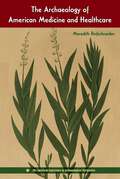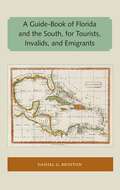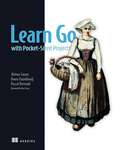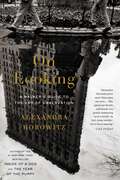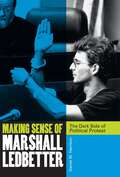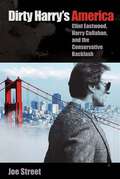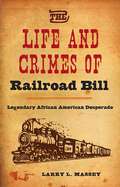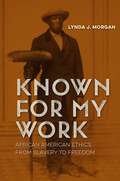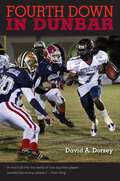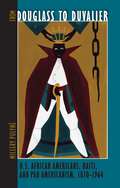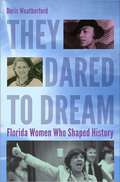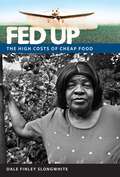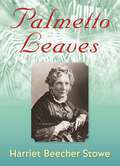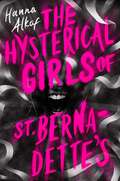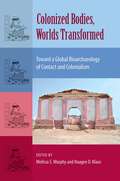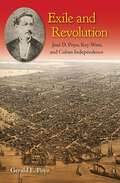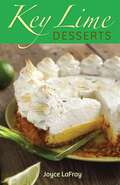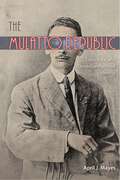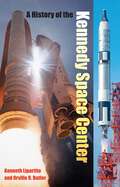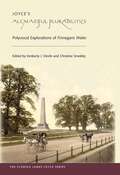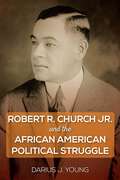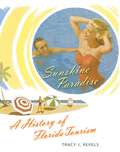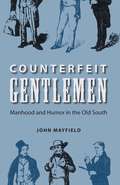- Table View
- List View
The Archaeology of American Medicine and Healthcare (The American Experience in Archaeological Perspective)
by Meredith ReifschneiderIn this book, Meredith Reifschneider synthesizes archaeological research on healthcare and medicine to show how practices in the United States have evolved since the nineteenth century, demonstrating that historical archaeology can provide important insights into healthcare and modes of self-care in the past.
A Guide-Book of Florida and the South, for Tourists, Invalids, and Emigrants: For Tourists, Invalids And Emigrants, With A Map Of The St. John River (classic Reprint) (Florida and the Caribbean Open Books Series)
by Daniel G. BrintonThe books in the Florida and the Caribbean Open Books Series demonstrate the University Press of Florida’s long history of publishing Latin American and Caribbean studies titles that connect in and through Florida, highlighting the connections between the Sunshine State and its neighboring islands. Books in this series show how early explorers found and settled Florida and the Caribbean. They tell the tales of early pioneers, both foreign and domestic. They examine topics critical to the area such as travel, migration, economic opportunity, and tourism. They look at the growth of Florida and the Caribbean and the attendant pressures on the environment, culture, urban development, and the movement of peoples, both forced and voluntary. The Florida and the Caribbean Open Books Series gathers the rich data available in these architectural, archaeological, cultural, and historical works, as well as the travelogues and naturalists’ sketches of the area in prior to the twentieth century, making it accessible for scholars and the general public alike. The Florida and the Caribbean Open Books Series is made possible through a grant from the National Endowment for the Humanities and the Andrew W. Mellon Foundation, under the Humanities Open Books program.
Learn Go with Pocket-Sized Projects
by Aliénor Latour Donia Chaiehloudj Pascal BertrandPocket-size projects, modular and versatile skills! Take your Go programming capabilities to the next level with 11 engaging applications.Learn Go with Pocket-Sized Projects teaches some of the most important skills of Go programming—including Go&’s unique idiomatic syntax—all through building fun and useful apps and games. Each project is fully working, simple to write, and easy to scale-up to full-size Go applications. In Learn Go with Pocket-Sized Projects you&’ll build: • A Wordle-alike game • A currency converter application • A habit-tracking application • A book digest application • A maze-solving algorithm • A microcontroller-based traffic lights program • …and more! Each small, self-contained project in Learn Go with Pocket-Sized Projects introduces important practical skills, including ensuring that your code is thoroughly tested and documented! You&’ll make architectural decisions for your projects and organize your code in a maintainable way. Work your way through, and you&’ll be able to utilize Go for everything from server-side applications to low-level systems programming. Foreword by Ron Evans. About the technology There&’s no more satisfying way to learn a programming language than by building your own projects! Whether you&’re coming from another language or taking your next steps in Go, these eleven projects will get you working hands on faster than you can type &“Bonjour le monde.&” About the book Learn Go with Pocket-Sized Projects introduces the most important features, concepts and techniques of the Go programming language. You&’ll learn hands on as you build fun mini projects including a Wordle clone you can run as a web service and a maze solver that uses goroutines. Along the way, you&’ll explore a wide range of topics, including Go&’s unique approach to interfaces, concurrency, REST and gRPC microservice APIs, and more. What's inside • Concurrency with goroutines • A habit tracker using gRPC and HTML templates • Deploying a secure web service • A microcontroller-based traffic lights program using TinyGo About the reader For beginners with Go or another programming language. About the author Aliénor Latour, Donia Chaiehloudj, and Pascal Bertrand are experienced developers with a passion for Go and excellence in programming. Table of Contents 1 MeetGo 2 Hello, earth! Extend your hello, world 3 A bookworm&’s digest: Playing with loops and maps 4 A log story: Creating a library 5 Gordle: Play a word game in your terminal 6 Money converter: CLI around an HTTP call 7 Caching with generics 8 Gordle as a service 9 Concurrent maze solver 10 Habits tracker using gRPC 11 HTML templating with a gRPC client 12 Go for other architectures Appendixes A Installation steps B Formatting cheat sheet C Zero values D Benchmarking E Passing by value or by reference F Fuzzing G Connecting to a database
On Looking: A Walker's Guide to the Art of Observation
by Alexandra HorowitzFrom the author of the #1 New York Times bestseller Inside of a Dog, this “elegant and entertaining” (The Boston Globe) explanation of how humans perceive their environments “does more than open our eyes...opens our hearts and minds, too, gently awakening us to a world—in fact, many worlds—we’ve been missing” (USA TODAY).Alexandra Horowitz shows us how to see the spectacle of the ordinary—to practice, as Sir Arthur Conan Doyle put it, “the observation of trifles.” Structured around a series of eleven walks the author takes, mostly in her Manhattan neighborhood, On Looking features experts on a diverse range of subjects, including an urban sociologist, the well-known artist Maira Kalman, a geologist, a physician, and a sound designer. Horowitz also walks with a child and a dog to see the world as they perceive it. What they see, how they see it, and why most of us do not see the same things reveal the startling power of human attention and the cognitive aspects of what it means to be an expert observer.Page by page, Horowitz shows how much more there is to see—if only we would really look. Trained as a cognitive scientist, she discovers a feast of fascinating detail, all explained with her generous humor and self-deprecating tone. So turn off the phone and other electronic devices and be in the real world—where strangers communicate by geometry as they walk toward one another, where sounds reveal shadows, where posture can display humility, and the underside of a leaf unveils a Lilliputian universe—where, indeed, there are worlds within worlds within worlds.
Inside of a Dog: What Dogs See, Smell, and Know (Playaway Adult Nonfiction Ser.)
by Alexandra HorowitzNOW FULLY REVISED AND UPDATED! The beloved #1 New York Times bestseller that &“causes one&’s dog-loving heart to flutter with astonishment and gratitude&” (The New York Times Book Review).The instant classic on the mind of the dog is now updated to include the latest results in the booming field of dog cognition. What do dogs know? How do they think? The answers will surprise and delight you as cognitive scientist Alexandra Horowitz explains how dogs perceive their daily worlds, each other, and that other quirky animal, the human. Inside of a Dog is a fresh look at the world of dogs—from the dog&’s point of view. In clear, crisp prose, Horowitz introduces the reader to dogs&’ perceptual and cognitive abilities and then draws a picture of what it might be like to be a dog. What&’s it like to be able to smell not just every bit of open food in the house but also to smell human emotions and even the passage of time? What is it like to have such good hearing that they notice the bodily vibrations of insects and the hum of a fluorescent light? Horowitz&’s engaging narrative allows us to replace our urge to anthropomorphize dogs with a true understanding of the canine experience. What&’s it like to use your mouth as a hand? How does a tiny dog manage to play successfully with a Great Dane? Why must a person on a bicycle be chased? This fully revised and updated edition also reflects the latest findings on canine perception, dogs&’ understanding of our emotions and of our language, and the evolving story of domestication. Some discoveries are not only informative but curiously amusing, such as dogs&’ asymmetrical nostril use and their alignment with the earth&’s magnetic field when pooing. Much more than a scientific exploration; Inside of a Dog is a love letter to dogs, filled with personal observations and practical advice for people who live with dogs. With a light touch and the weight of scientific authority behind her, Horowitz offers an unparalleled exploration into the minds of our beloved four-legged companions.
Making Sense of Marshall Ledbetter: The Dark Side of Political Protest
by Daniel M. HarrisonArmed with an empty whiskey bottle and wearing a tie-dyed Jimi Hendrix T-shirt, Florida State University dropout Marshall Ledbetter broke into the Florida State Capitol early one morning in June 1991. He occupied the Sergeant of Arms suite, demanding an extra-large Gumby’s pizza and 666 donuts for the cops waiting outside. He hoped to garner media attention for his protest of poverty, homelessness, and cuts to higher education.After an eight hour standoff, Ledbetter was betrayed by the very media he had counted on to tell his story; his demands were not broadcast on CNN as he had been promised but streamed into the office on closed-circuit TV. Although he left the building peacefully, the ensuing trial, his trips in and out of the state’s mental health institutions over the following decade, and his eventual suicide in 2003 speak to how difficult it is to untangle addiction, isolation, brilliance, and deviance.Ledbetter’s invasion of the Capitol remains the biggest security breach of the building’s history, but Daniel Harrison’s telling of the Ledbetter saga is about more than one misguided young man’s breaking and entering into the state’s most secure building. Making Sense of Marshall Ledbetter thoughtfully and honestly explores the ways society manages deviant people in real world situations and whether or not our law enforcement and justice systems are adequately equipped to handle mental illness.
Dirty Harry's America: Clint Eastwood, Harry Callahan, and the Conservative Backlash
by Joe Street"Street provides a crucial critical and cultural service by not only studying Eastwood’s individual films in sharp detail but also by providing a close and serious analysis of the cultural and historic times of the films."—Sam B. Girgus, author of Clint Eastwood’s America "By far the most comprehensive, sustained, and detailed discussion of the Dirty Harry phenomenon. A thorough and engaging account of how a fictitious renegade cop became an enduring icon of the angry conservative backlash that sought to halt 1960s liberalism in its tracks."—Nick Heffernan, author of Culture, Environment and Ecopolitics Clint Eastwood’s Dirty Harry became the prototype for a new kind of movie cop—an antihero in pursuit of his own vision of justice. The Dirty Harry series helped cement Eastwood and his character, Harry Callahan, as central figures in 1970s and 1980s Hollywood cinema. In Dirty Harry’s America, Joe Street argues that the movies shed critical light on the culture and politics of the post-1960s era and locates San Francisco as the symbolic cultural battleground of the time. Across the entire series, conservative anger and moral outrage confront elitist liberalism and moral relativism. Paying particular attention the films' representation of crime, family and community, sexuality, and race, Street maintains that through referencing real events and political struggles, the films themselves became active participants in the culture wars. Unapologetic carrier of right and might, Harry Callahan becomes America’s Ur-conservative: "unbending, moral, incorruptible, and most important, always right." Long after the series, Callahan’s legacy remains strong in American political discourse, cinema, and pop culture, and he continues to shape Eastwood’s later political and cinematic career.
The Life and Crimes of Railroad Bill: Legendary African American Desperado
by Larry L. MasseyFor over a year, Railroad Bill eluded sheriffs, private detectives hired by the L&N line, and bounty hunters who traveled across the country to match guns with the legendary desperado. The African American outlaw was wanted on multiple charges of robbery and murder, and rumor had it that he stole from the rich to give to the poor. He terrorized busy train lines from east of Mobile to the Florida Panhandle, but as soon as the lawmen got close, he disappeared into the bayous and pine forests--until one day his luck ran out, and he was gunned down inside a general store in Atmore, Alabama.Little is known about Railroad Bill before his infamy--not his real name or his origins. His first recorded crime, carrying a repeating rifle without a license, led him into a gunfight with a deputy and made him a wanted man throughout Florida in 1894. His most celebrated escape--a five-day foot chase with scores of men and several bloodhounds--led to tales of Railroad's supernatural ability to transmogrify into an animal or inanimate object at will. As his crimes progressed from robbing boxcars to wounding trainmen to murdering sheriffs, more and more reward money was offered for his capture--dead or alive.Today, Railroad Bill is the subject of many folk songs popularized by singers such as Paul McCartney, Taj Mahal, Gillian Welch, and Ramblin' Jack Elliot. But who was he? Where did he come from? What events led to his murderous spree? And why did some view him as a hero?In Railroad Bill, Larry Massey separates fact from myth and teases out elusive truths from tall tales to ultimately reveal the man behind the bandit's mask.
Known for My Work: African American Ethics from Slavery to Freedom
by Lynda J. Morgan“Demonstrates that the ‘emancipation generation’ bequeathed values, ethical frameworks, and identities to multiple ensuing generations, shaping religious, educational, and cultural institutions as well as labor and political organizations.”—Peter Rachleff, editor of Starving Amidst Too Much and Other IWW Writings on the Food Industry “Shows how far off the mark arguments are that claim that black Americans generally have internalized inferiority and engage in self-defeating behaviors.”—William A. Darity Jr., coeditor of Boundaries of Clan and Color: Transnational Comparisons of Inter-Group Disparity In Known for My Work, Lynda Morgan looks beyond slavery’s legacy of racial and economic inequality and counters the idea that slaves were unprepared for freedom. By examining African American social and intellectual thought, Morgan highlights how slaves built an ethos of “honest labor” and collective humanism. As moral economists, slaves and their descendants insisted that economic motives formed the foundation of their exploitation and made sophisticated arguments about the appropriate role of labor in a just and democratic society. Morgan considers how slaves evaluated the violence, coercions, and deceits employed by slaveholders as means to maintain power, as well as the ways in which fugitive slaves active in the abolition movement stressed to nonslaveholding audiences how they were complicit in a regime fraught with moral decay. She also points to the racial rhetoric of Jim Crow architects and how it was readily identified as elaborating on slave-era racial propaganda in new ways for an old reason: to establish a rigid economic inequality in the Industrial Revolution. From the late antebellum era through Reconstruction, labor organizing in the 1930s and 1940s, the civil rights movement of the 1960s and 1970s, and the reparations movement of the twenty-first century, Morgan offers an unprecedented view of African America. What emerges from the literature is a clear critique of racism, an embrace of self-defense, and the belief that they deserved reparations for lost labor. Enslaved laborers thought for themselves, imagined themselves, and made themselves. Moreover, their descendants share this moral legacy as a foundation for citizenship and participation in democracy.
Fourth Down in Dunbar: Guns, Drugs, And Nfl Dreams
by David A. DorseyFor the young men of Dunbar—the low-income, historically segregated neighborhoods of Fort Myers, Florida—avoiding the path that leads to easy money as a drug dealer often means choosing complete devotion to football and dreams of NFL stardom. While such dreams remain out of reach for most, an astonishing number of Dunbar athletes, including NFL idols Deion Sanders, Jevon Kearse, and Earnest Graham, have achieved massive success.Fourth Down in Dunbar is the story of how one community, plagued by drugs and violence, where many children are fatherless, gave rise to so many stellar youth athletes. Using Sanders as the centerpiece of the story, David Dorsey explores Dunbar’s history to show how the same drug culture that ruined so many promising futures also served as motivation for football success. As a reporter for the Fort Myers News-Press, Dorsey had exclusive access to the players and their relatives. He shows the success of the wildly talented as well as the regrets of those who took the wrong path, while highlighting hope for the future of Dunbar.In this poignant tale of heartbreak and triumph, Dorsey reveals the true nature of these men who overcame the obstacles in their lives and made their families and their hometown proud.
From Douglass to Duvalier: U.S. African Americans, Haiti, and Pan Americanism, 18701964 (New World Diasporas)
by Millery PolynéHaiti has long been both a source of immense pride--because of the Haitian Revolution--and of profound disappointment--because of the unshakable realities of poverty, political instability, and violence--to the black diasporic imagination. Charting the long history of these multiple meanings is the focus of Millery Polyne's rich and critical transnational history of U.S. African Americans and Haitians.Stretching from the thoughts and words of American intellectuals such as Frederick Douglass, Robert Moton, and Claude Barnett to the Civil Rights era, Polyne's temporal scope is breathtaking. But just as impressive is the thematic range of the work, which carefully examines the political, economic, and cultural relations between U.S. African Americans and Haitians.From Douglass to Duvalier examines the creative and critical ways U.S. African Americans and Haitians engaged the idealized tenets of Pan Americanism--mutual cooperation, egalitarianism, and nonintervention between nation-states--in order to strengthen Haiti's social, economic, and political growth and stability. The depth of Polyne's research allows him to speak confidently about the convoluted ways that these groups have viewed modernization, "uplift," and racial unity, as well as the shifting meanings and importance of the concepts over time.
They Dared to Dream: Florida Women Who Shaped History
by Doris Weatherford"Well-crafted and in-depth, They Dared to Dream has moved women, their experiences, and their contributions to the forefront of Florida's history and heritage. This is a long-overdue and much-needed turning point in understanding our state's past and present."--Canter Brown Jr., coeditor of The Varieties of Women's Experiences "Represents a leap forward in the study of Florida history. Weatherford has done an outstanding job of researching and writing about Florida women, from paupers to queens, elevating their status to a level of equality within the overall story of Florida."--Rodney Kite-Powell, Saunders Foundation Curator of History at the Tampa Bay History Center and editor of Tampa Bay History "Exhaustively researched, well written, and engaging, They Dared to Dream breaks new ground in the study of Florida. Doris Weatherford's ambitious history of women in Florida will be widely read and discussed. From Princess Ulele to Alex Sink, from the role of criollas in Colonial St. Augustine to the struggles of women in the twenty-first century, Weatherford chronicles their lives in the Sunshine State."--Gary Mormino, author of Land of Sunshine, State of Dreams In this extensive portrayal of Florida's guiding matriarchs, Doris Weatherford highlights the myriad contributions women have made throughout Florida's history. From the select few who traveled with Ponce de Leon to the state's first female mayor Marion H. O’Brien, Weatherford sheds light on the roles these pioneering women played in the shaping of the Sunshine State. They Dared to Dream reveals the lifestyles and achievements of women throughout landmark moments in history, including Native civilizations before the arrival of European colonists; early Spanish, British, and French exploration, the Civil War era, Reconstruction, the early twentieth century, and the population explosions post-World War II. Featuring often-celebrated personalities--including Mary Martha Reid, Harriet Beecher Stowe, and Elizabeth Cady Stanton--alongside the lesser-known lives of Princess Murat, lighthouse keeper Barbara Mabrity, Florida Memorial College founder Sarah Ann Blocker, and others--this pivotal examination of Florida's female agents of change draws attention to women's instrumental roles in the historical events that defined the Sunshine State. From prehistoric times to the space age, the female half of the population has made giant, but too often unacknowledged, contributions to Florida history. Countless women have overcome great obstacles and yet are often left out of historical accounts. They Dared to Dream aims to fill in some of these gaps by celebrating the many successes women have made. Because without women, there is no history--nor any future. Doris Weatherford is the author of A History of the American Suffragist Movement and other reference guides on American women’s history. The Florida Commission on the Status of Women Foundation, Inc., is dedicated to empowering women and girls in our state by supporting educational, entrepreneurial and self sufficiency programs and initiatives through grants, mentoring, and other opportunities. The FCSW Foundation supports the work and programs of the Florida Commission on the Status of Women, including the Florida Women's Hall of Fame. The Florida Commission on the Status of Women Foundation, Inc. dedicates this book to: the women of the past who struggled to achieve gender equality and showed the path, the women of the present who continue with the same goal, and the women of the future who will carry the baton and make us proud.--Dr. Mona Jain Acknowledgments, by the Florida Commission on the Status of Women Foundation, Inc The Florida women’s history book project could not have been completed without the cooperation and support of many people. To thank all of them who made it possible would be nearly impossible. We would, however, like to express our sincere appreciation to those who have helped take this endeavor "from dream to reality." First and foremost, we are indebted forever t
Fed Up: The High Costs of Cheap Food
by Dale Finley SlongwhiteOne farmworker tells of the soil that would “bite” him, but that was the chemicals burning his skin. Others developed lupus, asthma, diabetes, kidney failure, or suffered myriad symptoms with no clear diagnosis. Some miscarried or had children with genetic defects, while others developed cancer.In Fed Up, Dale Slongwhite collects the nearly inconceivable and chilling oral histories of African American farmworkers whose lives, and the lives of their families, were forever altered by one of the most horrific pesticide exposure incidents in United States’ history.For decades, the farms around Lake Apopka, Florida’s third largest lake, were sprayed with chemicals ranging from the now-banned DDT to toxaphene. Among the most productive farmland in America, the fields were doused with organochlorine pesticides, also known as persistent organic pollutants; the once-clear waters of the lake turned pea green; birds, alligators, and fish died at alarming rates; and still the farmworkers planted, harvested, packed, and shipped produce all over the country, enduring scorching sun, snakes, rats, injuries, substandard housing, low wages, and the endocrine disruptors that crop dusters dropped as they toiled.Eventually, state and federal dollars were allocated to buy out and close farms to attempt land restoration, water clean up, and wildlife rehabilitation. But the farmworkers became statistics, nameless casualties history almost forgot. Here are their stories, told in their own words.
Creating Citizenship in the Nineteenth-Century South
by William A. Link, David Brown, Brian Ward and Martyn Bone"This is a remarkable collection of essays. Citizenship clearly forms the backbone for these investigations but the range of the contributors’ backgrounds (in terms of disciplinary training) and the approaches they take to the question makes this collection both broad and deep. As it turns out, there is no other way to tackle a concept as central but also as slippery as citizenship. A shorter or more focused collection would miss the nuances and insights that this one offers."—Aaron Sheehan-Dean, author of Why Confederates Fought: Family and Nation in Civil War Virginia "President Obama’s citizenship continues to be questioned by the ‘birthers,’ the Cherokee Nation has revoked tribal rights from descendants of Cherokee slaves, and Parliament in the U.K. is debating ‘citizenship education.’ It is in both this broader context and in the narrower academic one that Creating Citizenship in the Nineteenth-Century South stands as a smart, exciting, and most welcome contribution to southern history and southern studies."—Michele Gillespie, author of Katharine and R.J. Reynolds: Partners of Fortune and the Making of the New South "Combining historical and cultural studies perspectives, eleven well-crafted essays and a provocative epilogue engage the economic, political, and cultural dynamics of race and belonging from the era of enslavement through emancipation, reconstruction, and the New South."—Nancy A. Hewitt, author of Southern Discomfort More than merely legal status, citizenship is also a form of belonging, shaping individual and group rights, duties, and identities. The pioneering essays in this volume are the first to address the evolution and significance of citizenship in the American South during the long nineteenth century. They explore the politics and contested meanings of citizenry from a variety of disciplinary perspectives in a tumultuous period when slavery, Civil War, Reconstruction, and segregation redefined relationships between different groups of southern men and women, both black and white.
Palmetto Leaves (Florida Sand Dollar Books)
by Harriet Beecher StoweIn 1867, the author of Uncle Tom’s Cabin settled in a small cottage in Mandarin, Florida, overlooking the St. Johns River. She had promised her Boston publisher another novel but was so taken with northeast Florida that she produced instead a series of sketches of the land and the people which she submitted in 1872 under the title Palmetto Leaves.Stowe describes life in Florida in the latter half of the 19th century—"a tumble-down, wild, panicky kind of life—this general happy-go-luckiness which Florida inculcates." Her idyllic sketches of picnicking, sailing, and river touring expeditions and simple stories of events and people in this tropical "winter summer" land became the first unsolicited promotional writing to interest northern tourists in Florida.
The Hysterical Girls of St. Bernadette's
by Hanna AlkafFour starred reviews! An all-girls school is struck with mysterious cases of screaming hysteria in this dark academia &“thrilling mix of ghost story and realism&” (School Library Journal, starred review) haunted by a deeply buried history clawing to the light.For over a hundred years, girls have fought to attend St. Bernadette&’s, with its reputation for shaping only the best and brightest young women. Unfortunately, there is also the screaming. When a student begins to scream in the middle of class, a chain reaction starts that impacts the entire school. By the end of the day, seventeen girls are affected—along with St. Bernadette&’s stellar reputation. Khadijah&’s got her own scars to tend to, and watching her friends succumb to hysteria only rips apart wounds she&’d rather keep closed. But when her sister falls to the screams, Khad knows she&’s the only one who can save her. Rachel has always been far too occupied trying to reconcile her overbearing mother&’s expectations with her own secret ambitions to pay attention to school antics. But just as Rachel finds her voice, it turns into screams. Together, the two girls find themselves digging deeper into the school&’s dark history, hunting for the truth. Little do they know that a specter lurks in the darkness, watching, waiting, and hungry for its next victim…
Colonized Bodies, Worlds Transformed: Toward A Global Bioarchaeology of Contact and Colonialism (Bioarchaeological Interpretations of the Human Past: Local, Regional, and Global)
by Melissa S. Murphy and Haagen D. Klaus"Breaks new ground regarding how to think about colonial encounters in innovative ways that pay attention to a wide range of issues from health and demography to identity formations and adaptation."—Debra L. Martin, coeditor of The Bioarchaeology of Violence "Amply demonstrates the breadth and variability of the impact of colonialism."—Ken Nystrom, State University of New York at New Paltz European expansion into the New World fundamentally altered Indigenous populations. The collision between East and West led to the most recent human adaptive transition that spread around the world. Paradoxically, these are some of the least scientifically understood processes of the human past. Representing a new generation of contact and colonialism studies, this volume expands on the traditional focus on the health of conquered peoples by considering how extraordinary biological and cultural transformations were incorporated into the human body and reflected in behavior, identity, and adaptation.By examining changes in diet, mortuary practices, and diseases, these globally diverse case studies demonstrate that the effects of conquest reach further than was ever thought before—to both the colonized and the colonizers. People on all sides of colonial contact became entangled in cultural and biological transformations of social identities, foodways, social structures, and gene pools at points of contact and beyond. Contributors to this volume illustrate previously unknown and variable effects of colonialism by analyzing skeletal remains and burial patterns from never-before-studied regions in the Americas to the Middle East, Africa, and Europe. The result is the first step toward a new synthesis of archaeology and bioarchaeology.Contributors: Rosabella Alvarez-Calderón | Elliot H. Blair | Maria Fernanda Boza | Michele R. Buzon | Romina Casali | Mark N. Cohen | Danielle N. Cook | Marie Elaine Danforth | J. Lynn Funkhouser | Catherine Gaither | Pamela García Laborde| Ricardo A. Guichón | Rocio Guichón Fernández | Heather Guzik | Amanda R. Harvey | Barbara T. Hester | Dale L. Hutchinson | Kristina Killgrove | Haagen D. Klaus | Clark Spencer Larsen | Alan G. Morris | Melissa S. Murphy | Alejandra Ortiz | Megan A. Perry | Emily S. Renschler | Isabelle Ribot | Melisa A. Salerno | Matthew C. Sanger | Paul W. Sciulli | Stuart Tyson Smith | Christopher M. Stojanowski | David Hurst Thomas | Victor D. Thompson | Vera Tiesler | Jason Toohey | Lauren A. Winkler | Pilar Zabala
Exile and Revolution: José D. Poyo, Key West, and Cuban Independence
by Gerald E. PoyoJosé Dolores Poyo (1836-1911) was an activist, publisher, social critic, fundraiser, and foundational figure in the campaign for Cuban independence from Spain. His leadership and his mantra-"adelante la revolución" (forward the revolution)-mobilized an insurrectionist movement in Key West. His multidimensional grassroots work and his newspaper El Yara, the longest-lived Cuban exile newspaper of the nineteenth century, gave hope to a people who aspired to be liberated from the bonds of colonialism. In Exile and Revolution, Gerald Poyo provides a comprehensive account of how his great-great-grandfather spurred the working-class community of Key West to transform their roles as supporting cast to become critical actors in the struggle for Cuban independence. The book reveals the depth of Cuba’s longtime ties to Florida, the cigar industry, and its workers; the experience of Cubans in the American South; and the diplomatic intrigues involving Spain, Cuba, and the United States.
Key Lime Desserts
by Joyce LaFrayA delicious and versatile fruit, the Key Lime is an exotic addition to back yard gardens and a favorite on restaurant menus. Gourmets and novices alike will rave over easy-to-prepare recipes such as Key Lime Drop Cookies, Frozen Key Lime Cake Supreme, and Key Lime Rum Sherbet. Not to be forgotten are variations on traditional Key Lime pie including Black Bottom Key Lime Pie, Mango Key Lime Pie, and Key Lime Ice Cream Pie.
The Mulatto Republic: Class, Race, and Dominican National Identity
by April J. Mayes&“Impels the reader to not lean solely on the crutch of Dominican anti-Haitianism in order to understand Dominican identity and state formation. Mayes proves that there was a multitude of factors that sharpen our knowledge of the development of race and nation in the Dominican Republic.&”—Millery Polyné, author of From Douglass to Duvalier &“A fascinating book. Mayes discusses the roots of anti-Haitianism, the Dominican elite, and the ways in which race and nation have been intertwined in the history of the Dominican Republic. What emerges is a very interesting and engaging social history.&”—Kimberly Eison Simmons, author of Reconstructing Racial Identity and the African Past in the Dominican Republic The Dominican Republic was once celebrated as a mulatto racial paradise. Now the island nation is idealized as a white, Hispanic nation, having abandoned its many Haitian and black influences. The possible causes of this shift in ideologies between popular expressions of Dominican identity and official nationalism has long been debated by historians, political scientists, and journalists.In The Mulatto Republic, April Mayes looks at the many ways Dominicans define themselves through race, skin color, and culture. She explores significant historical factors and events that have led the nation, for much of the twentieth century, to favor privileged European ancestry and Hispanic cultural norms such as the Spanish language and Catholicism.Mayes seeks to discern whether contemporary Dominican identity is a product of the Trujillo regime—and, therefore, only a legacy of authoritarian rule—or is representative of a nationalism unique to an island divided into two countries long engaged with each other in ways that are sometimes cooperative and at other times conflicted. Her answers enrich and enliven an ongoing debate. Publication of this digital edition made possible by a Sustaining the Humanities through the American Rescue Plan grant from the National Endowment for the Humanities.
A History of the Kennedy Space Center
by Kenneth Lipartito Orville R ButlerThis first comprehensive history of the Kennedy Space Center, NASA's famous launch facility located at Cape Canaveral, Florida, reveals the vital but largely unknown work that takes place before the rocket is lit. Though the famous Vehicle Assembly Building and launch pads dominate the flat Florida landscape at Cape Canaveral and attract 1.5 million people each year to its visitor complex, few members of the public are privy to what goes on there beyond the final outcome of the flaring rocket as it lifts into space. With unprecedented access to a wide variety of sources, including the KSC archives, other NASA centers, the National Archives, and individual and group interviews and collections, Lipartito and Butler explore how the methods and technology for preparing, testing, and launching spacecraft have evolved over the last 45 years. Their story includes the Mercury and Gemini missions, the Apollo lunar program, the Space Shuttle, scientific missions and robotic spacecraft, and the International Space Station, as well as the tragic accidents of Challenger and Columbia. Throughout, the authors reveal the unique culture of the people who work at KSC and make Kennedy distinct from other parts of NASA.
Joyce's Allmaziful Plurabilities: Polyvocal Explorations of Finnegans Wake (Florida James Joyce)
by Kimberly J. Devlin and Christine Smedley“A brilliantly collaged snapshot of the variety and wealth of literary criticism, and Joyce studies, today.”—Tony Thwaites, author of Joycean Temporalities “Celebrates the multiplicity and sheer rampant excess of Joyce’s prodigally polysemous text with seventeen different scholars employing a likewise prodigal range of critical methodologies.”—Patrick O’Neill, author of Impossible Joyce: Finnegans Wakes “Each of the scholars involved is at the top of his and her game. Their commitment and excitement about the task at hand is evident on virtually every page. This book makes the Wake relevant and accessible to a whole new generation of readers.”—Garry Leonard, author of Advertising and Commodity Culture in Joyce This is the first Finnegans Wake guide to focus exclusively on the multiple meanings and voices in Joyce’s notoriously intricate diction. Rather than leveling the text it illuminates many layers of puns, wordplay, and portmanteaus, celebrating the Wake’s central experimental technique. Renowned Joyce scholars explore the polyvocality of individual chapters using game theory, ecocriticism, psychoanalysis, historicism, myth, philosophy, genetic studies, feminism, and other critical frameworks. They set in motion cross-currents and radiating structures of meaning that permeate the entire text and open up satisfying readings of the Wake for novices and seasoned readers alike. A volume in the Florida James Joyce Series, edited by Sebastian D. G. Knowles
Robert R. Church Jr. and the African American Political Struggle
by Darius J. YoungSouthern Conference on African American Studies, Inc., C. Calvin Smith Book AwardThis volume highlights the little-known story of Robert R. Church Jr., the most prominent black Republican of the 1920s and 1930s. Tracing Church’s lifelong crusade to make race an important part of the national political conversation, Darius Young reveals how Church was critical to the formative years of the civil rights struggle. A member of the black elite in Memphis, Tennessee, Church was a banker, political mobilizer, and civil rights advocate who worked to create opportunities for the black community despite the notorious Democrat E. H. “Boss” Crump’s hold over Memphis politics. Spurred by the belief that the vote was the most pragmatic path to full citizenship in the United States, Church founded the Lincoln League of America, which advocated for the interests of black voters in over thirty states. He was instrumental in establishing the NAACP throughout the South as it investigated various incidents of racial violence in the Mississippi Delta. At the height of his influence, Church served as an advisor for Presidents Harding and Coolidge, generating greater participation of and recognition for African Americans in the Republican Party. Church’s life and career offer a window into the incremental, behind-the-scenes victories of black voters and leaders during the Jim Crow era that set the foundation for the more nationally visible civil rights movement to follow. Publication of the paperback edition made possible by a Sustaining the Humanities through the American Rescue Plan grant from the National Endowment for the Humanities.
Sunshine Paradise: A History of Florida Tourism (The Florida History and Culture Series)
by Tracy J. RevelsFor nearly two hundred years, Floridians have eagerly exploited tourism as the key to economic prosperity. As a result, the state has constantly reshaped and remodeled itself as different types of tourist heavens, and many aspects of its history have become inseparable from the fantastic images created by the tourism industry. From spa retreats to nature preserves, from riverboat rides to roller coasters, and from railroads to theme parks, the state’s dependence on tourism has greatly shaped its identity.Sunshine Paradise is the first book to focus exclusively on how--and why--tourism came to define Florida. Offering a concise look at the subject from the 1820s to the present, Tracy Revels demonstrates tourism’s relevance to all other major aspects of Florida history, including the Civil War, the land boom, and civil rights.In this enjoyable and well-written history, Revels shows how Florida’s tourism industry has remained adaptive and expansive, ready to sell the next version of paradise to northerners hungry for sunshine. She also explains why the state’s business and political leaders must consider the history of tourism development as they plan for the state’s future.
Counterfeit Gentlemen: Manhood and Humor in the Old South (New Perspectives on the History of the South)
by John MayfieldWhat does it mean to be a man in the pre–Civil War South? And how can we answer the question from the perspective of the early twenty-first century? John Mayfield does so by revealing how early nineteenth-century Southern humorists addressed the anxieties felt by men seeking to chart a new path between the old honor culture and the new market culture. Lacking the constraints imposed by journalism or proper literature, these writers created fictional worlds where manhood and identity could be tested and explored.
